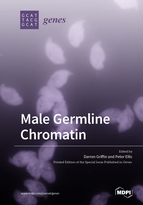Male Germline Chromatin
A special issue of Genes (ISSN 2073-4425). This special issue belongs to the section "Molecular Genetics and Genomics".
Deadline for manuscript submissions: closed (31 December 2018) | Viewed by 41376
Special Issue Editors
Interests: chromosomes; cytogenetics; aneuploidy; genome evolution; chromosome segregation; infertility; IVF
Special Issues, Collections and Topics in MDPI journals
2. Centre for Interdisciplinary Studies of Reproduction (CISoR),University of Kent, Canterbury, Kent CT2 7NJ, UK
Interests: evolution; reproduction; testis; meiosis; spermatogenesis; DNA damage; chromatin; epigenetics; genomics;
Special Issue Information
Dear Colleagues,
Spermatogenesis requires radical restructuring of germline chromatin at multiple stages, involving co-ordinated waves of DNA methylation and demethylation, histone modification, replacement and removal occurring before, during and after meiosis. This Special Issue will draw together papers addressing all aspects of chromatin organization and dynamics in the male germ line, in humans and in model organisms. In particular, we will invite authors to discuss novel methods for studying germline chromatin structure, the interplay between chromatin structure and susceptibility to DNA damage and mutation, chromatin modifications associated with epigenetic inheritance in the early embryo, and the impact this work has for understanding natural fertility and improving assisted reproduction techniques.
Prof. Darren Griffin
Dr. Peter Ellis
Guest Editors
Manuscript Submission Information
Manuscripts should be submitted online at www.mdpi.com by registering and logging in to this website. Once you are registered, click here to go to the submission form. Manuscripts can be submitted until the deadline. All submissions that pass pre-check are peer-reviewed. Accepted papers will be published continuously in the journal (as soon as accepted) and will be listed together on the special issue website. Research articles, review articles as well as short communications are invited. For planned papers, a title and short abstract (about 100 words) can be sent to the Editorial Office for announcement on this website.
Submitted manuscripts should not have been published previously, nor be under consideration for publication elsewhere (except conference proceedings papers). All manuscripts are thoroughly refereed through a single-blind peer-review process. A guide for authors and other relevant information for submission of manuscripts is available on the Instructions for Authors page. Genes is an international peer-reviewed open access monthly journal published by MDPI.
Please visit the Instructions for Authors page before submitting a manuscript. The Article Processing Charge (APC) for publication in this open access journal is 2600 CHF (Swiss Francs). Submitted papers should be well formatted and use good English. Authors may use MDPI's English editing service prior to publication or during author revisions.
Keywords
- spermatogenesis
- chromatin
- nuclear organisation
- DNA oxidation
- DNA fragmentation
- epigenetic inheritance
- histone retention
- assisted reproduction
- in vitro fertilisation








